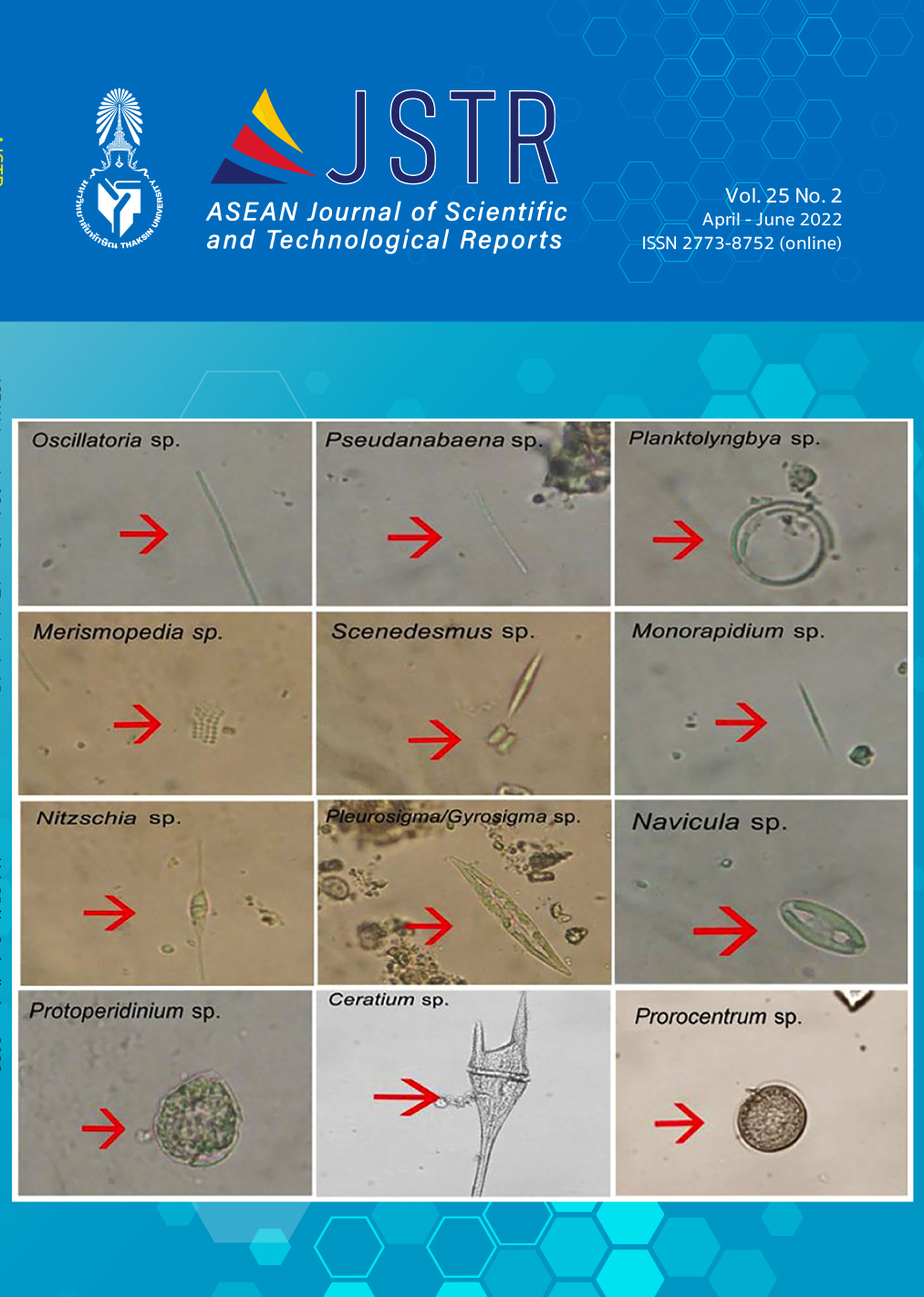Effect of Nickel Concentration on Ozone Production using Nickel-Antimony Doped Tin Oxide for Wastewater Treatment
Main Article Content
Abstract
Nickel-antimony doped tin oxide (NATO) catalyst has greatly considered its capability to treat high organic matter and eliminate colour in wastewater as palm oil mill wastewater with electrochemical ozone generation. This study presents the optimal Ni content of NATO and its properties to enhance ozone generation. The NATO anodes were fabricated by dip-coating, varying the Ni content between 0.5% and 5%. The key findings show that all anodes showed a single phase of rutile structure with the cracked mud on the surface. The binding energies of the Sb3d3/2 peak at 540.48 eV and 541.58 eV agree with Sb3+ and Sb5+, respectively. The optimal ozone current efficiency of 37% at the current density of ca. 0.22 A cm-2 in 0.5 M H2SO4 at 2.7V was obtained on the NATO anode with 2% Ni content calcined at 700 oC. The palm oil mill wastewater treatment result showed that decolourisation TOC and COD removal efficiency increased with increasing electrolysis time. The colour removal efficiency achieved was more than 85% for a reaction time of 15 min. The efficiency of TOC and COD removal was reached ca. 80% in 20 min. The overall results appeared that NATO with electrochemical ozone generation could be employed to treat palm oil mill wastewater with high efficiency due to •OH and O3.
Article Details

This work is licensed under a Creative Commons Attribution-NonCommercial-NoDerivatives 4.0 International License.
References
Abidin, C.Z.A.; Fahmi.; A.H., Ibrahim.; N.R., Rahmat.; R., Ahmad.; N.F.M., Hussein.; P.S., Choong.; P.K. Singa. Effect of electrode materials on the degradation of palm oil mill effluent by electro-oxidation process. IOP Conference Series: Earth and Environmental Science, 2021; 646(1), pp. 012027.
Muharam, S.; Gunlazuardi, J.; Ivandini, T.A. Electro-oxidation of palm oil mill effluent using a boron-doped diamond anode. IOP Conference Series: Materials Science and Engineering, 2019; 496, pp. 012001.
Alhaji M.H.; Sanaullah, K.; Lim, S.-F.; Khan, A.; Hipolito, C.N.; Abdullah, M.O.; Bhawani, S.A.; Jamil. T., Photocatalytic treatment technology for palm oil mill effluent (POME) – A review. Process Safety and Environmental Protection, 2016; 102(Supplement C), pp. 673-686.
Christensen, P.A.; Attidekou, P.S.; Egdell, R.G.; Maneelok, S.; Manning, D.A.C. An in situ FTIR spectroscopic and thermogravimetric analysis study of the dehydration and dihydroxylation of SnO2: the contribution of the (100), (110) and (111) facets. Physical Chemistry Chemical Physics, 2016; 18(33), pp. 22990-22998.
Christensen P.A., Yonar, T.; Zakaria, K. The Electrochemical Generation of Ozone: A Review. Ozone-Science & Engineering, 2013; 35(3), pp. 149-167. doi: 10.1080/01919512.2013.761564.
Zakaria K..; Christensen, P.A. The Use of Ni/Sb-SnO2-based Membrane Electrode Assembly for Electrochemical Generation of Ozone and the Decolourisation of Reactive Blue 50 Dye Solutions. Electrochimica Acta, 2014; 135, pp. 11-18. doi: 10.1016/j.electacta.2014.05.013.
Wang Y.H.; Chan, K.Y.; Li, X.Y.; So, S.K., Electrochemical degradation of 4-chlorophenol at nickel–antimony doped tin oxide electrode. Chemosphere, 2006; 65(7), pp. 1087-1093. doi: 10.1016/j.chem osphere.
04.061
Supandee Maneelok P.S.A.; Paul A.Christensen Application of electrochemical ozone generation on Nickel/antimony-doped tin oxide (Ni/Sb-SnO2) electrodes to decolourisation and degradation of Reactive Blue 50 dye. Proceedings of the 11st Challenging in Environmental Science and Engineering 2018. Bangkok, Thailand.
Sun Z.R.; Zhang, H.; Wei, X.F.; Ma, X.Y., Hu, X. Preparation and electrochemical properties of SnO2-Sb-Ni-Ce oxide anode for phenol oxidation. Journal of Solid State Electrochemistry, 2015, 19(8): p. 2445-2456.
Parsa J.B.; Abbasi, M. Decolorization of synthetic and real wastewater by indirect electrochemical oxidation process. Acta Chimica Slovenica, 2007; 54(4), pp. 792.
Cheng C.K.; Deraman, M.R.; Ng, K.H.; Khan, M.R. Preparation of titania doped argentum photocatalyst and its photoactivity towards palm oil mill effluent degradation. Journal of Cleaner Production, 2016; 112(Part 1), pp. 1128-1135.
Mohammad S.; Baidurah, S.; Kobayashi, T.; Ismail, N.; Leh, C.P. Palm Oil Mill Effluent Treatment Processes—A Review. Processes, 2021; 9(5), pp. 739.
Ng K.H.; Cheng, C.K. A novel photomineralization of POME over UV-responsive TiO 2 photocatalyst: kinetics of POME degradation and gaseous product formations. RSC Advances, 2015; 5(65), pp. 53100-53110.
Sontaya K., Pitiyont B.; Punsuvon, V. Decolorization and COD removal of palm oil mill wastewater by electrocoagulation. International Journal of Environmental Science and Technology, 2013; 7, pp. 370-4.
Eaton A.D.; Clesceri, L.S.; Greenberg, A.E.; Franson, M.A.H.; American, A. Public Health, A.; American Water Works, F. Water Environment, Standard methods for the examination of water and wastewater. 1998; Washington, DC: American Public Health Association.
Yang S.Y.; Y.S. Choo, S.; Kim, S.K.; Lim, J. Lee.; H. Park, Boosting the electrocatalytic activities of SnO2 electrodes for remediation of aqueous pollutants by doping with various metals. Applied Catalysis B-Environmental, 2012; 111, pp. 317-325.
Shekarchizade, H.; Amini, M.K.; Effect of Elemental Composition on the Structure, Electrochemical Properties, and Ozone Production Activity of Ti/Sn-Sb-Ni Electrodes Prepared by Thermal Pyrolysis Method. International Journal of Electrochemistry, 2011; 2011, pp. 13.
Wang Y.H.; Nie, Z.Z.; Liang, Y.R. Characterization of Nickel-Antimony Doped Tin Oxide Electrodes Prepared via Sol-Gel Dip-Coating Method. Advanced Materials Research, 2013; 734-737, pp. 2155-2158.
Babar A.R.; Shinde, S.S.; Moholkar, A.V.; Bhosale, C.H.; Rajpure, K.Y. Structural and optoelectronic properties of sprayed Sb:SnO2 thin films: Effects of substrate temperature and nozzle-to-substrate distance. Journal of Semiconductors, 2011; 32(10), pp. 102001.
Montilla F.; Morallón, E.; De Battisti, A.; Barison, S.; Daolio, S.; Vázquez, J.L. Preparation and Characterization of Antimony-Doped Tin Dioxide Electrodes. 3. XPS and SIMS Characterization. The Journal of Physical Chemistry B, 2004; 108(41), pp. 15976-15981.
Comninellis, C; Chen, G. Electrochemistry for the Environment, C. Comninellis, G. Chen, and SpringerLink, Editors. 2010; New York : Springer: New York.


